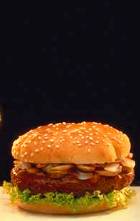
By stitching together segments of two species of infectious yeast proteins, called prions, researchers have produced a hybrid prion that can adopt two distinct infectious shapes. This ability to change conformation allows the hybrid prion to bridge a species barrier and “infect” proteins from two distantly related species of yeast. This phenomenon, say the scientists, may be a key to understanding how prions derived from cows infected with bovine spongiform encephalopathy (BSE), or “mad cow disease,” can hop the species barrier and infect humans.
The ability of a single prion protein to fold into multiple infectious forms, say the scientists, means that knowledge of the shape of a prion, and not simply what species it came from, is critical to understanding which hosts it can infect.
Weissman and graduate student Peter Chien of UCSF published their studies in the March 8, 2001, issue of the journal Nature.
The scientists conducted their studies using yeast prions, which are similar to the mammalian prions that have gained notoriety for their roles in such fatal brain-destroying human diseases such as Creutzfeldt-Jakob disease and kuru, and in the animal diseases BSE and scrapie.
Both yeast and mammalian prions are proteins that transmit their characteristics via protein-protein interactions in which an abnormally shaped prion protein influences its normal counterpart to assume an abnormal shape. In mammalian prion infections, abnormal, insoluble shapes trigger protein clumping that can kill brain cells. In yeast cells, the insoluble prion protein is not deadly; it merely alters a cell’s metabolism. “In mammalian prions, it was known that the same prion protein, even within genetically identical hosts, could cause more than one type of disease,” said Weissman. “And similarly, the same yeast prions could have different strains with different characteristics.
“This strain diversity had been one of the greatest mysteries about prions,” he said. “Although it had been proposed that prion strain differences resulted from alternative conformations of the prion protein itself, the theory was difficult to test directly. The problem was that in mammalian prions it was never possible to unambiguously create the infectious form of the prion with the pure protein in vitro. So it couldn’t be ruled out that there were other components that caused the apparent differences in conformation.”
Chien and Weissman chose to use yeast prions because the pure proteins are easily manipulated and propagated in vitro. Their work built on earlier studies from the Weissman lab that demonstrated that a species barrier prevented cross infection between prions derived from two distantly related yeast species, Saccharomyces cerevisae (SC) or Candida albicans (CA).
In the present studies, the scientists produced a chimera of the SC and CA prion proteins by combining one segment of the SC prion with another segment of the CA prion.
“We found that this chimera was ‘promiscuous,'” said Weissman. “That is, it could be converted to the aggregated prion form by either species of yeast, thus bridging the species barrier. However, the prion strain conformation that resulted in each case was dramatically different.
“But the really remarkable thing was that each of these alternate conformations could subsequently induce conversion of only the yeast species that had initially seeded it, but not the other,” said Weissman. “It was surprising that we would get such a clean and simple answer—that this phenomenon that had been so mysterious and difficult to study could be shown with a pure protein to be due directly to self-propagating differences in conformation.”
According to Weissman, discovery of the conformational basis of different yeast prion strains has important implications for understanding mammalian prions.
“We cannot take comfort in the fact that the cow prion protein has a different sequence than the human prion, because if the cow prion has assumed a conformation that’s virulent in humans, it won’t be held up effectively by a species barrier,” he said.
“An important lesson both from the mammalian prion work and from our studies is that there is no simple answer to the question of whether we are protected from being infected by prions from animals such as cows,” said Weissman. “The key factor will be a prion’s strain conformation, which means that it will be critically important to understand on a molecular level the differences among mammalian prion strains.” Also, he said, the effects of treatment of prion-containing meat might have enhanced the virulence of the prions.
“While this remains speculative, it could be that the prion strain changed as it was passaged,” he said. “There might have been a kind of evolution based on selection of a strain conformation among a diversity of conformations, rather than mutations in a DNA genome as occurs with viruses or cellular life.
“What we are learning from both yeast and mammalian prions raises the disturbing possibility that the process of infecting, heat-rendering of the animal parts, and then re-infecting cows might actually have selected for a prion strain conformation that is particularly virulent and resistant to being inactivated,” Weissman said. “So, it might have been this very process that humans set up that made the bovine prion so virulent and created the epidemic of mad cow disease.”


















Comments are closed.